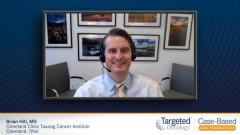
Unmet Needs and Future Directions in Mantle Cell Lymphoma
Brian Hill, MD, reviews unmet needs and future directions in the management of mantle cell lymphoma.
Episodes in this series

Brian Hill, MD: Looking forward, with the unmet needs in mantle cell lymphoma in the relapsed setting, a proportion of patients may need this treatment but are potentially not sufficiently fit to receive it. This may be because they are experiencing the burden of the disease.
If patients are encountered who are relapsing with mantle cell lymphoma and have poor performance status, it is beneficial to see the field and all our community colleagues giving the benefit of the doubt and their potential candidacy for CAR [chimeric antigen receptor] T-cell treatment. With nontoxic targeted therapies, like the oral BTK inhibitors, it’s quite likely that patients bounce back quickly as their constitutional or B symptoms improve. If their appetite, weight, and other indicators of their performance status improve, they then may become candidates for CAR T-cell therapy down the road.
The timing of that can be difficult because patients may be optimally controlled after some period of time, 6 or 12 months or longer, or an oral BTK inhibitor. The therapies are not going to work forever. One of the challenges going forward is the timing of when to move forward with CAR T, particularly if the patient is enjoying a remission with an oral BTK inhibitor and having minimal adverse effects. It can be a difficult sell to the doctor or the patient to go forward with CAR T. It’s going to be difficult to know when to do that, because if you wait too long and they start exhibiting disease progression or refractory lymphoma, it may be hard or more difficult to make the arrangements that are needed to treat them with CAR T-cell therapy.
In the future, there will be a lot of interest in identifying the patients who are unlikely to do well with standard chemoimmunotherapy. There are certain disease or molecular characteristics of the disease, including TP53 mutation, blastoid variant, and Ki-67, among others. Typically, these patients don’t have great outcomes with chemoimmunotherapy. Moving forward, there’s likely to be prospective studies that look to use CAR T-cell therapy in earlier lines of therapy for patients with these high-risk features.
Community oncologists may not be seeing mantle cell lymphoma patients at high frequency to their practice. If a community oncologist sees 1 as a newly diagnosed mantle cell, or maybe someone treated several years ago who’s now relapsing, it is encouraged that the community oncologists make a phone call to their referral center to get a little advice on the most up-to-date approach for these patients.
There are studies that might use CAR T or other approaches in early lines of therapy. The easiest thing to do is to start a BTK inhibitor. Sometimes, when making that initial second-line therapy, it’s a good opportunity to get the patient tied in with a referral center that may be able to offer CAR T-cell therapy in the near future should it be needed.
Transcript edited for clarity.
Case: A 73-Year-Old Male With Mantle Cell Lymphoma
History
- A 73-year-old man was diagnosed with mantle cell lymphoma in 2016
- He was treated with rituximab, dexamethasone, cytarabine + carboplatin followed by autologous stem cell transplant; achieved PR; continued rituximab maintenance therapy
- Ann Arbor stage IV; MIPI score 6.7, high risk
- Late 2019 he experienced clinical relapse and was started on ibrutinib; achieved SD
Currently
- He complains of a 2-month history of loss of appetite and fatigue
- PMH: hyperlipidemia, medically well-controlled
- PE: bilateral clavicular and cervical lymphadenopathy; otherwise unremarkable
- Labs: WBC 11 X 109/L, hemoglobin 9.5 gm/dL, plt 96,000/u, LDH 405 U/I, ANC 3200/mm3
- Lymph node biopsy: IHC; cyclin D1+, CD5 +, CD10+, CD20+, FISH: t (11;14)
- C/A/P CT scan: widespread lymphadenopathy including bilateral clavicular (2.4 cm, 1.5 cm), and inguinal region (4.6 cm)
- PET/CT shows diffuse uptake of 18F-FDG in the clavicular, axillary and inguinal lymph nodes
- Beta-2-microglobulin 4.1 µg/L
- ECOG PS 0
- Treatment was started with fludarabine + cyclophosphamide, followed by a single infusion of CAR T-cell therapy









































